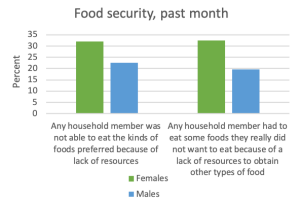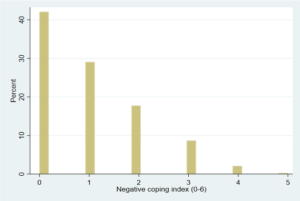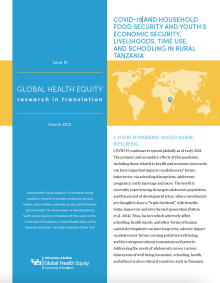Issue 15: COVID-19 and Household Food Security and Youth Economic Security, Livelihoods, Time Use, and Schooling in Rural Tanzania
Global Health Equity Research in Translation brings academic research to broader audiences: decision makers, policy makers, advocacy groups, philanthropists, and journalists. The series draws on transdisciplinary health equity research completed with the support of the Community of Excellence in Global Health Equity at the University at Buffalo, The State University of New York.
I. COVID-19 PANDEMIC AND ECONOMIC WELLBEING
COVID-19 continues to spread globally as of early 2021. The primary and secondary effects of this pandemic, including those related to health and economic insecurity, can have important impacts on adolescents’ future trajectories, via schooling disruptions, adolescent pregnancy, early marriage and more. The world is currently experiencing its largest adolescent population, and this period of development is key, where investments are thought to have a “triple dividend”, with benefits today, tomorrow and into the next generation (Patton et al. 2014). Thus, factors which adversely affect schooling, health inputs, and other forms of human capital development can have long-term, adverse impact on adolescents’ future earning potential, well-being, and the intergenerational transmission of poverty. Addressing the needs of adolescents across various dimensions of well-being (economic, schooling, health, and others) is also critical if countries such as Tanzania are to attain the so-called “Demographic Dividend,”i with important implications for whether a country can reach its full economic potential (Gribble et al. 2012). In Tanzania, social distancing precautions, school closures implemented early in the pandemic, and external factors such as reduced demand for export, reductions in tourism, disruptions to supply chains, and inflation compounded by exchange rate pressures have affected livelihoods and economic security. Policymakers interested in strengthening social protection and designing other education and economic support programs to improve the schooling and economic outcomes of adolescents, and subsequently, their future economic security, need more information about how the pandemic is affecting youth’s livelihoods, time use, and schooling. In this brief, we summarize the effects of the pandemic on household food security and youth’sii economic security, livelihoods, time use, and schooling among a sample of youth participating in the Productive Social Safety Net Program (PSSN).
Executive Summary
We find that the most salient impacts of the COVID-19 pandemic in this population have been increases in economic insecurity. The pandemic has come in the wake of another economic shock, namely long delays in cash transfer payments from an anti-poverty program in which these households participate. Thus, the participants have faced a decrease in their income for several months, and COVID-19 has worsened their economic insecurity. After COVID-19 began, income-generating activities were hindered by closures of businesses, inability to transport goods and supplies, and fear of going out into crowds to sell. Simultaneously, prices increased and households had difficulties buying certain basic needs. Food insecurity was reported by a significant portion of both youth (one in four) and household heads (one in three). While school attendance was disrupted due to closures, most children were reported to have gone back once schools reopened, and community leaders monitored attendance and supported some children who were delayed in returning. However, some households still reported financial difficulties in sending their children to school. Compared to approximately one year prior, youth increased the time they spent in a variety of economic activities. Youth also reported an array of negative coping strategies, which may harm their longer-term economic well-being, including selling livestock and agricultural assets and taking out loans. To mitigate these adverse impacts on vulnerable households, we recommend expanding social protection; complementary programming including efforts related to water, sanitation and hygiene to reduce gender inequitable time burdens; economic strengthening programming; and temporarily waiving requirements around school dress code to alleviate financial barriers to school attendance.
Findings
Sample Characteristics
Youth in this sample were on average 20 years old (range 17-24), and 22% were married (26 percent of females and 19 percent of males) at the time of interview. Just under 14% were attending school prior to COVID-19-related closures (16% of females and 12% of males).
Detrimental impacts of COVID-19 on livelihoods and economic activities
Nearly all adolescents, in qualitative interviews, reported major economic impacts to their households during the COVID-19 pandemic. Barriers to economic activity included fear of being in crowds, closures of businesses, and inability to transport goods and supplies. Many of the adolescents’ families were involved in buying and selling produce and other goods, but “people were afraid of going out to sell due to the pandemic.” Farmers had difficulty getting fertilizer and produce rotted before it could be sold.
At both the community and youth levels, in qualitative interviews, participants reported improvements in economic conditions recently, though the reopening brought with it greater risk of COVID-19 spread. However, some continue to struggle, as they spent their savings during the closures, and now struggle to obtain the capital they need to restart businesses—to buy fertilizer for fields or to buy building materials for construction, for example.
When asked about changes in their standard of living compared to six months ago (in quantitative surveys), 56% of youth reported that it was staying the same, 15% reported it was getting worse, and 29% reported it was getting better. Females were more likely than males to report improvements in their standard of living.
COVID-19 induced changes to food and water security
Some households reported difficulties getting enough food during this period, due to increased financial strains and other challenges. Prices went up, especially for sugar, beans, tomatoes, and other basic commodities. In quantitative surveys, 51 percent of respondents reported that prices had increased more than usual in the markets they usually shop at, as compared to March 2020. One adolescent said, “Getting supplies was a challenge, because they were not available when you wanted them.” In some cases, food was available in the market but “people were afraid to go out and bring more supplies.” These findings were also supported in the quantitative surveys, where food insecurity was reported by many respondents. Twenty-seven percent reported that household members were not able to eat the kinds of food they preferred in the past month due to a lack of resources, while 25 percent reported that household members had to eat some foods they really did not want to eat because of a lack of resources to obtain other types of food, either sometimes or often in the past month. Females were more likely than males to report food insecurity. Further, 38 percent of respondents reported that they had tried to purchase food or essential items but were unable to due to limited supply or items not being available in the market. Over time, in the household SMS surveys, an increasing percentage of households reported food insecurity. In November 2020, 47% reported eating unwanted foods, while in January 2021 60% did so.
A few households also reported water insecurity, which is problematic for effective hygiene practices to prevent transmission of COVID-19. Six percent of households reported that someone in the household had to go without washing hands after performing dirty activities (for example, defecating, changing diapers, or cleaning animal dung) because of problems with water in the same time period.
Figure 1: Food security, past month

Disruption in routine time use activities
When schools closed, some children and youth became more involved in household chores, such as fetching water or gathering firewood, or family economic activities. As one community member explained, “Some were even selling vegetables, without worrying about the presence of diseases, for the economy of the household.” Children were reported to be engaging in activities such as collecting scrap metal, farming, gathering garbage, and selling mandazi, secondhand clothes, and produce. One adolescent said of her siblings, “when I was alone at home, I had a lot of work to do, but during the time when they were at home, they really helped me a lot with work.”
Females reported twice as much time spent in domestic chores and caring as compared to males. This is typical in this setting, where gender norms dictate many behaviors and activities. When comparing to a year prior (pre-COVID) in multivariate regressions controlling for age and other characteristics, youth were more likely to be engaged in the following activities: any work, farm work, livestock work, household business work, and paid work. Moreover, youth reported spending, on average, 0.41 more hours caring for elderly, 0.82 more hours gathering firewood, and 0.16 more hours collecting nuts or other tree fruits, honey, or other products from forests in the past day, as compared to one year prior. This is consistent with reports in the qualitative interviews. Changes in these time use activities are likely in response to food insecurity, so youth are more engaged in collecting food for the household, and may also be a substitution effect, whereby when adults in the household need to take on more paid work outside the household, youth become more engaged in domestic chores within the household. Over time, among youth who participated in all SMS rounds, 40% of youth reported increasing amounts of time spent in farming, tending livestock or fishing.
Heavy work for schoolchildren seemed relatively rare, however, because most respondents said they were trying to stay home and social distance during COVID-19. “A large percentage remained locked up in their homes,” said one community member. An adolescent, speaking of his siblings, said, “Because we needed to protect them a lot they did not do any activities, they had to stay inside.”
Material and financial barriers to school attendance/return
According to qualitative interviews, almost all children and youth in the adolescents’ households who were enrolled in school before the pandemic returned when schools reopened. As one community leader reported, “There was also an effort to follow-up and make sure children returned to school. Therefore, there were not many cases of children not reporting to school…many reported because we took steps early.”
Nevertheless, in quantitative household surveys, 15% of households reported that a lack of money prevented them from sending children to school in the past 4 weeks. Given the average age (20 years) in our quantitative adolescent/youth sample, most were not in school themselves. In fact, only 14% were attending school prior to school closings in March 2020. The top three reasons for not attending school prior to March were not having money or fees for uniforms (41%), having failed the promotion exam (29%), or already having acquired all their desired education (20%). In regression analyses, there was no significant difference in school attendance, as compared to one year prior.
One adolescent mentioned a delay in a sibling’s return to school due to financial constraints. Fees were due when schools reopened, and COVID-19’s effects on the economy made this more difficult than usual. “He did not return immediately because he didn’t have some of the requirements. How could he go to school without them? He had to wait until we got them… He returned to school after two weeks… Since there is no one to run to for help all I could do was to tell him to be patient, and God is great, I got the money and he returned to school.” There were also isolated cases of delayed return due to financial pressures reported by community members. One said, “there is a child who said he did not report to school because he had no school materials. We had caught him at the bus station picking empty tins to sell, claiming he had no school materials.” The community member assisted the child, who then returned to school. The differences in qualitative and quantitative reports of effects on school attendance may be explained by the fact that households reported financial difficulties in affording school-related costs, while qualitative reports (among both community members and adolescents) reported that ultimately all or most children were able to return to school, including those where difficulties were addressed with community support. As reported directly by youth, the rates of school attendance remained relatively similar over time between SMS rounds 1 (November 2020) and 4 (January 2021; ranging from 25% to 29%).
Though most children returned to school, participants noted the negative impacts of lost time during the closures. During that time, students largely studied on their own, or with minimal support from siblings or adults in the household. “Studying alone and studying in a group is different,” said one adolescent participant. One community member noted that students in this rural area were disadvantaged because they did not have access to the same resources as students in urban areas. “Their fellow children…those in town, the majority were listening…watching TV, following lessons on TV.” Only one of the participants in this study mentioned the availability of educational media, via television and smartphones. Generally, reviewing textbooks was students’ only educational activity.
Negative coping strategies
Participants used a variety of coping strategies to address the financial challenges brought on by the COVID-19 pandemic. Seven of the 46 adolescent participants in qualitative interviews reported selling land or livestock—chickens, pigs, and cows. In four cases, participants said that they or someone else in their households had taken loans. In a few cases, participants changed to different businesses or became subsistence farmers, to ensure that the household would have food. There were barriers to changing economic activities, however. As one community member explained, “This created some difficulties, as you need to get used to the new activity that you are forced to do… This might require capital that you might not have.” Three qualitative interview participants reported transactional sexual relationships. Only 4% of females (n=15) in the quantitative surveys reported having started a sexual relationship with someone in the past 12 months for financial reasons.
Figure 2: Index of negative coping strategies, youth quantitative sample (n=760)

We examined a variety of coping strategies that households employed to cope with the adverse economic conditions, and among these were six negative coping strategies (changed eating patterns, sold agricultural assets, sold durable goods, sold land, sold crop stocks, sold livestock). On average, households engaged in one negative coping strategy in the past six months. These negative coping strategies can temporarily provide resources to combat food insecurity; however, they will likely decrease income-generating potential in the future, with adverse implications for future economic well-being.
II. TAKEAWAYS
This study examined impacts of COVID-19 on the economic (including food and water) security, livelihoods, schooling, and time use of youth in rural Tanzania. Economic impacts were the main impacts for the sample—over health or other concerns. Food insecurity was prevalent, and respondents reported rising prices for food and difficulties obtaining items needed. In addition, some households reported water insecurity, with implications for proper sanitation and COVID-19 prevention. In response to this economic insecurity, one in three youth in the sample reported that their households engaged in negative coping strategies in the previous six months. Moreover, youth engaged in more labor and increased time spent in domestic chores. However, it appears this was limited to our older youth sample, and younger children in the households were spared increased labor activities in an effort to protect them from COVID-19 exposure, as reported in qualitative interviews.
While community leaders reported that all children went back to school, some households reported delays in children returning to school due to economic difficulties. PSSN payments resumed in September 2020 after a delay of 18 months (one payment was made in the interim), and this may help mitigate economic insecurity. In addition to the pandemic, vulnerable households participating in the Government’s flagship social protection program, the PSSN, simultaneously faced delays in the bi-monthly cash transfer payments between March 2019 and September 2020. The amounts of these payments are conditional on school attendance for school-age children (starting with the December 2020 payment cycle, as conditions were waived for payments received in September/October 2020), which may mean that some households struggling to afford items necessary to send children to school (books, uniforms, informal fees, etc.) may receive lower PSSN payments, further making it difficult to send their children to school.
Limitations of the study include the mobile nature of the data collection and the fact that we leveraged an existing sample, which was comprised of adolescents and youth in PSSN households, who tend to be poorer than the general population.
In order to mitigate these adverse impacts on vulnerable households, government, development partners, and civil society can advocate and implement the following measures:
- Social protection: Ensure that PSSN payments are implemented on schedule (without further delays) moving forward.
- Complementary programming: Implement water, sanitation, and hygiene programming in communities examined to alleviate water insecurity, prevent transmission of infectious diseases, and reduce gendered domestic chores burdens.
- School policies: Waive requirements around school dress codes during emergency periods (for example, pandemics, recessions, or severe food shortages).
- Economic strengthening: Scale up agricultural extension programming to promote resiliency and increased productivity of crop production and livestock keeping, to mitigate negative coping strategies such as selling of agricultural assets and livestock in emergency periods.
III. METHODS
This study takes place in Southern Tanzania, in Mbeya located in the South West Highlands and Iringa located in the Southern Highlands zone. Both regions produce cash crops for export, including coffee, tea, and spices. The main sector of employment is agriculture, and the population in these regions face high rates of child stunting, high fertility, and high rates of HIV/AIDS. Data used in this study come from a longitudinal study, which sampled adolescents between the ages of 14 and 19 years (in 2017) living in households participating in the Government’s flagship social protection program, the Productive Social Safety Net (PSSN) (UNICEF Office of Research 2020). Study districts and councils include Mufindi and Mafinga in the Iringa region and Rungwe and Busokelo in the Mbeya region. The study areas (130 villages total) are generally remote, rural villages. For this COVID-19 study, four distinct groups were sampled: adolescents, household heads, community leaders, and health facility staff. The eligibility criteria for adolescents/youth were: being a participant of the existing longitudinal study; and a) being aged 18 years or older; or b) being married and aged 18 years or less. A total of 760 structured interviews were completed. Among the eligible sample, we purposively selected 46 youth to additionally interview in depth with semi-structured interviews. In addition to data collection among youth, we interviewed a sub-sample of 542 household heads in households where the adolescents live and staff in 83 government-run, primary health care facilities in the study area via mobile phone and asked them four short questions. We also conducted qualitative interviews with 16 randomly selected community leaders. Data collection occurred via mobile phone in September and October 2020. All interviews were conducted in Swahili. Topics covered in the interviews ranged from COVID-19 knowledge prevention; illness and health services utilization; food and water insecurity; time use, including economic activities and chores; mental health; violence; and exploitation. Additional data were collected via SMS with households and youth during the following dates: Round 1: 17 - 30 November; Round 2: 1 - 8 December 2020; Round 3: 15 - 22 December 2020; Round 4: 13 - 20 January 2021. More information on coding and analyses of data can be found in the full report cited at the end of this brief.
REFERENCES
Gribble, J & J. Bremner. 2012. The Challenge of Attaining the Demographic Dividend. Population Reference Bureau. https://www.prb.org/demographic-dividend/. Published 2012. Accessed September 8, 2018.
Patton, G.C., Ross, D.A., Santelli, J.S., Sawyer, S.M., Viner, R.M., & S. Kleinert. 2014. Next steps for adolescent health: a Lancet Commission. The Lancet 383(9915): 385-386.
UNICEF Office of Research - Innocenti. 2020. Tanzania Cash Plus Evaluation Team. A Cash Plus Model for Safe Transitions to a Healthy and Productive Adulthood. Round 3 Report.
ACKNOWLEDGEMENTS
Funding for this mobile study on COVID-19 impacts has generously been provided by UNICEF Tanzania and Deutsche Gesellschaft für Internationale Zusammenarbeit GIZ GmbH under the umbrella of the P4H Health Financing Network. Funding for the larger study (2017-2019) from which the cohort was leveraged was provided by Oak Foundation (#OCAY-16-73); UNICEF Tanzania; as well as the UK’s Department of International Development (DFID 203529-102) and the Swedish Development Cooperation Agency (Sida G41102), both through a grant to UNICEF Office of Research—Innocenti supporting the Transfer Project.
AUTHORS
Stephanie Zuilkowski, Sarah Quiñones, Graca Marwerwe, Hassan Kihanzah, Leah Prencipe, Lusajo Kajula, and Tia Palermo
RECOMMENDED CITATION
Zuilkowski, Stephanie, Quiñones, Sarah, Marwerwe, Graca, Hamisi Kihanzah, Hassan, Prencipe, Leah, Kajula, Lusajo, and Palermo, Tia. COVID-19 and Household Food Security and Youth’s Economic Security, Livelihoods, Time Use, and Schooling in Rural Tanzania - Research Brief. Global Health Equity Research in Translation. Eds. Emmanuel Frimpong Boamah, Katarzyna Kordas, and Samina Raja. Community of Excellence in Global Health Equity, March 2021.
SOURCE TEXTS
Tia Palermo, Stephanie Zuilkowski, Sarah Quiñones, Graca Marwerwe, Hassan Kihanzah, Leah Prencipe, and Lusajo Kajula, on Behalf of the Tanzania Adolescent Cash Plus Evaluation Team. (2020). “Real-time monitoring of COVID-19 impact among adolescents and young people, their families, and communities in Southern Highlands regions in Tanzania.” UNICEF Tanzania and University at Buffalo: Dar es Salaam and Buffalo.
SERIES EDITORS
Dr. Emmanuel Frimpong Boamah, Dr. Katarzyna Kordas, and Dr. Samina Raja
DESIGN
Nicole Little
PRODUCTION
Alex Judelsohn
FOOTNOTE(S)
[i] The Demographic Dividend is a one-time opportunity for poverty reduction and accelerated economic growth due to changes in a country’s population structure.
[ii] The National Policy of Youth Development (2007) in Tanzania defines youth as 15-35 years.

